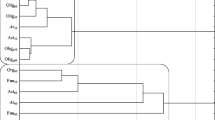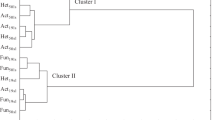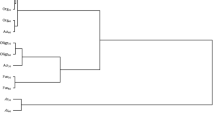Abstract
A greenhouse pot experiment was conducted at the University of Warmia and Mazury in Olsztyn, with the aim of describing the influence of metazachlor on counts and biodiversity of soil microorganisms, soil enzymatic activity, physicochemical properties of soil and yield of spring oilseed rape. The first experimental factor was soil contamination with increasing rates of metazachlor: 0 (soil without the herbicide), 0.333 (recommended by the manufacturer), 6.666, 13.332, 26.665, 53.328, 106.656 and 213.312 mg kg−1 dm of soil, while the second factor comprised two dates of determination: 30 and 60 days after starting the experiment. The tested herbicide had an adverse effect on reproduction of all analyzed microorganisms: oligotrophic bacteria and their endospore forms, Azotobacter spp. bacteria, organotrophic bacteria, actinomycetes and fungi. The values of the colony development and eco-physiological diversity indices decreased under the influence of excessive doses of the herbicide. Also, significant fluctuation in the enzymatic activity of soil was observed in response to the higher doses of metazachlor and depending on the date of determinations. The herbicide had an invariably negative influence on the activity of soil enzymes, causing the inhibition of dehydrogenases, catalase, urease, acid phosphatase, alkaline phosphatase, arylsulfatase and β-glucosidase. The physicochemical status of soil depended significantly on the degree of soil contamination with the herbicide, same as the yield of spring oilseed rape.


Similar content being viewed by others
References
Acosta-Martı′nez V, Acosta-Mercado D, Sotomayor-Ramı′rez D, Cruz-Rodrı′guez L (2008) Microbial communities and enzymatic activities under different management in semiarid soils. Appl Soil Ecol 38:249–260
Alef K, Nannipieri P (1998) Methods in Applied Soil Microbiology and Biochemistry. In: Alef K, Nannipieri P (eds) Academic Press, Harcourt Brace and Company, London, pp 316–365
Alef K, Nannipieri P, Trazar-Capeda C (1998) Phosphatase activity methods in applied soil microbiology and biochemistry. In: Alef K, Nannipieri P (eds) Academic Press, Harcourt Brace and Company, London, pp 335–344
Alexander M (1973) Microorganisms and chemical pollution. Bioscience 23:509–515
Anwar S, Liaquat F, Khan QM, Khalid ZM, Iqbal S (2009) Biodegradation of chlorpyrifos and its hydrolysis product 3,5,6-trichloro-2-pyridinol by bacillus pumilus strain C2A1. J Hazard Mater 168:400–405
Araújo ASF, Monteiro RTR, Abarkeli RB (2003) Effect of glyphosate on the microbial activity of two Brazilian soil. Chemosphere 52:799–804
Arias-Estéves M, López-Periago E, Martinez-Carbaloo E, Simal-Gándara J, Garciario L (2008) The mobility and degradation of pesticides in soils and the pollution of groundwater resources. Agric Ecosyst Environ 123:247–260
Baćmaga M, Boros E, Kucharski J, Wyszkowska J (2012) Enzymatic activity in soil contaminated with the Aurora 40 WG herbicide. Environ Prot Eng 38(1):91–102
Baćmaga M, Wyszkowska J, Borowik A, Tomkiel M, Kucharski J (2014) Response of fungi, β-glucosidase and arylsulfatase to soil contamination by Alister Grande 190 OD, Fuego 500 SC and Lumax 357.5 SE herbicides. Pol J Environ Stud 23(1):19–25
Beukle S, Malkomes HP (2001) Effects of the herbicides metazachlor and dinoterb on the soil microflora and the degradation and sorption of metazachlor under different environmental conditions. Biol Fertil Soils 33:467–471
Carter MR (1993) Soil sampling and methods of analysis. Canadian Society of soil science. Lewis Publishers, London
Crouzet O, Batisson I, Besse-Hoggan P, Bonnemoy F, Bardot C, Poly F, Bohatier J, Mallet C (2010) Response of soil microbial communities to the herbicide mesotrione: a dose-effect microcosm approach. Soil Biol Biochem 42:193–202
Cycoń M, Piotrowska-Seget Z (2009) Changes in bacterial diversity and community structure following pesticides addition to soil estimated by cultivation technique. Ecotoxicol 18(5):632–642
Cycoń M, Piotrowska-Seget Z, Kozdrój J (2010) Linuron effects on microbiological characteristics of sandy soils as determined in a pot study. Ann Microbiol 60(3):439–449
De Leij FAAM, Whipps JM, Lynch JM (1993) The use of colony development for the characterization of bacterial communities in soil and on roots. Microbiol Ecol 27:81–97
Eckermanna C, Matthesg B, Nimtzc M, Reiserb, Ledererb B, Bogerb P, Schrodera J (2003) Covalent binding of chloroacetamide herbicides to the active site cysteine of plant III polyketide synthases. Phytochemistry 64:1045–1054
Fenglerowa W (1965) Simple method for counting Azotobacter in soil samples. Acta Microbiol Pol 14:203–206
Gao Y, Zhou P, Mao L, Zhi Y, Shi W (2010) Assessment of effects of heavy metals combined pollution on soil enzyme activities and microbial community structure: modified ecological dose-response model and PCR-RAPD. Environ Earth Sci 60:603–612
Griesser UJ, Weigand D, Rollinger JM, Haddow M, Gstrein E (2004) The crystal polymorphs metazachlor. Identification and thermodynamic stability. J Therm Anal Cal 77:511–522
Jiang W, Wang J, Tang J, Hou F, Lu Y (2010) Soil bacterial functional diversity as influenced by cadmium, phenanthrene and degrade bacteria application. Environ Earth Sci 59:1717–1722
Kucharski J, Wyszkowska J (2008) Biological properties of soil contaminated with the herbicide Apyros 75 WG. J Elem 13(3):357–371
Kucharski J, Baćmaga M, Wyszkowska J (2009) Dehydrogenase activity as an indicator of soil contamination with herbicides. Ecol Chem Eng A 16(3):253–261
Laue H, Field JA, Cook AM (1996) Bacterial desulfonation of the ethanesulfonate metabolite of the chloroacetanilide herbicide metazachlor. Environ Sci Technol 30(4):1129–1132
Lazartigues A, Thomas M, Banas D, Brun-Bellut J, Cren-Olive C (2013) Accumulation and half-lives 13 pesticides in muscle tissue of freshwater fishes through food exposure. Chemosphere 91:530–535
Li X, Sarah P (2003) Arylsulfatase activity of soil microbial biomass along a mediterranean-arid transect. Soil Biol Biochem 35:925–934
Ma T, Zhu L, Wang J, Wang J, **e H, Su J, Zhang Q, Shao B (2011) Enhancement of atrazine degradation by crude and immobilized enzymes in two agricultural soils. Environ Earth Sci 64:861–867
Martin J (1950) Use of acid rose Bengal and streptomycin in the plate method for estimating soil fungi. Soil Sci 69:215–233
Martinez CO, Silva CMMS, Fay EF, Maia AHN, Abakerli RB, Durrant LR (2008) Degradation of the herbicide sulfentrazone in a Brazilian typic hapludox soil. Soil Biol Biochem 40:879–886
Milošević NA, Govedarica MM (2002) Effect of herbicides on microbiological properties of soil. Proc Nat Sci 102:5–21
Mohr S, Berghahn R, Feibicke M, Meineckie S, Ottenstroer T, Schmiedling R, Schmiediche R, Schmidt R (2007) Effects of herbicide metazachlor on macrophytes and ecosystem function in freshwater pond stream mesocosms. Aquat Toxicol 82:73–84
Mohr S, Feibicke M, Berghahn R, Schmiediche R, Schmidt R (2008) Response of plankton communities in freshwater pond and stream mesocosms to the herbicide metazachlor. Environ Poll 152:530–542
Mukherjee P, Alam S, Sardar D, Pahari A, Roy S, Chowdhury A (2006) Persistence and dissipation of linuron (Afalon-50 WP) in pea cropped soil and its effect on soil microorganisms. Bull Environ Contam Toxicol 76(3):407–414
Nelson DW, Sommers LE (1996) Total carbon, organic carbon, and organic matter. In: Sparks DL (ed) Method of soil analysis: chemical methods. American Society of Agronomy, Madison, pp 1201–1229
Öhlinger R (1996) Dehydrogenase activity with the substrate TTC Methods in Soil Biology. In: Schinner F, Öhlinger R, Kandler E, Margesin R (eds) Springer, Berlin, pp 241–243
Onta H, Hattori T (1983) Oligotrophic bacteria on organic debris and plant roots in paddy field. Soil Biol Biochem 1:1–8
Oosterhuisa B, Vukmana K, Vagia E, Glavinasa H, Jablonkaib I, Krajcis P (2008) Specific interactions of chloroacetanilide herbicides with human ABC transporter proteins. Toxicology 248:45–51
Parkinson D, Gray FRG, Williams ST (1971) Methods for studying the ecology of soil micro-organism. Blackwell Scientific Publication, Oxford and Edinburgh IBP Handbook 19
Rahmansyah M, Antonius S, Sulistinah N (2009) Phosphatase and urease instability caused by pesticides present in soil improved by grounded rice straw. J Agri Biol Sci 4(2):56–62
Ratcliff AW, Busse MD, Shestak CJ (2006) Changes in microbial community structure following herbicide (glyphosate) addition to forest soils. Appl Soil Ecol 34:114–124
Ros M, Goberna M, Moreno JL, Hernandez T, Garcı′a C, Insam H, Pascual JA (2006) Molecular and physiological bacterial diversity of a semi-arid soil contaminated with different levels of formulated atrazine. Appl Soil Ecol 34:93–102
Saha S, Dutta D, Karmakar R, Ray DP (2012) Structure–toxicity relationship of chloroacetanilide herbicides: relative impact on soil microorganisms. Environ Toxicol Pharmacol 34:307–314
Sarathchandra SU, Burch G, Cox NR (1997) Growth patterns of bacterial communities in the rhizoplane and rhizosphere of with clover (Trifolium repens L.) and perennial ryegrass (Lolium perenne L.) in long-term pasture. Appl Soil Ecol 6:293–299
Sebiomo A, Ogundero WV, Bankloe SA (2011) Effect of four herbicides on microbial population, soil organic matter and dehydrogenase activity. Afr J Biotech 10:770–778
Shiyin L, Lixiao N, Panying P, Cheng S, Liansheng W (2004) Effects of pesticides and their hydrolysates on catalase activity in soil. Bull Environ Contam Toxicol 72:600–606
Sofo A, Scopa A, Dumontet S, Mazzatura A, Pasquale V (2012) Toxic effects of four sulphonylureas herbicides on soil microbial biomass. J Environ Sci Health Part B 47:653–659
Statsoft, Inc, Statistica (2011) Data Analysis Software System, version 10. http://www.statsoft.com
Sukul P (2006) Enzymatic activities and microbial biomass in soil as influenced by metalaxyl residues. Soil Biol Biochem 38:320–326
World Reference Base of Soil Resources (2006) A framework for international classification, correlation and communication. World Soils Resources Report. 103, FAO, Rome
Wyszkowska J (2002) Effect of soil contamination with Treflan 480 EC on biochemical properties of soil. Pol J Environ Stud 11(1):71–77
Wyszkowska J, Kucharski J (2004) Biochemical and Physicochemical Properties of Soil Contaminated with Herbicide Triflurotox 250 EC. Pol J Environ Stud 13:223–231
Yao X, Min H, Lii Z, Yuan H (2006) Influence of acetamiprid on soil enzymatic activities and respiration. Eur J Soil Biol 42:120–126
Zabaloy MC, Garland JL, Gomez MA (2010) Assessment of the impact of 2,4-dichlorophenoxyacetic acid (2,4-D) on indigenous herbicide-degrading bacteria and microbial community function in an agricultural soil. Appl Soil Ecol 46:240–246
Acknowledgments
The experiment was conducted under the research project no N N305 386138 funded by the National Science Centre in Poland (the NCN).
Author information
Authors and Affiliations
Corresponding author
Rights and permissions
About this article
Cite this article
Baćmaga, M., Kucharski, J., Wyszkowska, J. et al. Responses of microorganisms and enzymes to soil contamination with metazachlor. Environ Earth Sci 72, 2251–2262 (2014). https://doi.org/10.1007/s12665-014-3134-8
Received:
Accepted:
Published:
Issue Date:
DOI: https://doi.org/10.1007/s12665-014-3134-8




